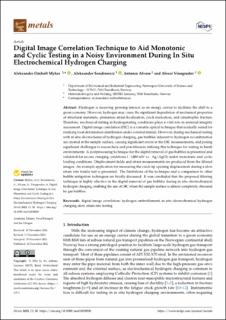| dc.contributor.author | Myhre, Aleksander Omholt | |
| dc.contributor.author | Sendrowicz, Aleksander | |
| dc.contributor.author | Alvaro, Antonio | |
| dc.contributor.author | Vinogradov, Alexei | |
| dc.date.accessioned | 2023-03-09T14:23:45Z | |
| dc.date.available | 2023-03-09T14:23:45Z | |
| dc.date.created | 2023-03-03T14:40:07Z | |
| dc.date.issued | 2022 | |
| dc.identifier.citation | Metals. 2022, 13 (1), 1-10. | en_US |
| dc.identifier.issn | 2075-4701 | |
| dc.identifier.uri | https://hdl.handle.net/11250/3057434 | |
| dc.description.abstract | Hydrogen is receiving growing interest as an energy carrier to facilitate the shift to a green economy. However, hydrogen may cause the significant degradation of mechanical properties of structural materials, premature strain localisation, crack nucleation, and catastrophic fracture. Therefore, mechanical testing in hydrogenating conditions plays a vital role in material integrity assessment. Digital image correlation (DIC) is a versatile optical technique that is ideally suited for studying local deformation distribution under external stimuli. However, during mechanical testing with in situ electrochemical hydrogen charging, gas bubbles inherent to hydrogen recombination are created at the sample surface, causing significant errors in the DIC measurements, and posing significant challenges to researchers and practitioners utilising this technique for testing in harsh environments. A postprocessing technique for the digital removal of gas bubbles is presented and validated for severe charging conditions (−1400 mV vs. Ag/AgCl) under monotonic and cyclic loading conditions. Displacement fields and strain measurements are produced from the filtered images. An example application for measuring the crack tip opening displacement during a slow strain rate tensile test is presented. The limitations of the technique and a comparison to other bubble mitigation techniques are briefly discussed. It was concluded that the proposed filtering technique is highly effective in the digital removal of gas bubbles during in situ electrochemical hydrogen charging, enabling the use of DIC when the sample surface is almost completely obscured by gas bubbles. | en_US |
| dc.language.iso | eng | en_US |
| dc.publisher | MDPI | en_US |
| dc.rights | Navngivelse 4.0 Internasjonal | * |
| dc.rights.uri | http://creativecommons.org/licenses/by/4.0/deed.no | * |
| dc.subject | slow strain rate testing | en_US |
| dc.subject | in situ electrochemical hydrogen charging | en_US |
| dc.subject | hydrogen embrittlement | en_US |
| dc.subject | digital image correlation | en_US |
| dc.title | Digital Image Correlation Technique to Aid Monotonic and Cyclic Testing in a Noisy Environment during In Situ Electrochemical Hydrogen Charging | en_US |
| dc.title.alternative | Digital Image Correlation Technique to Aid Monotonic and Cyclic Testing in a Noisy Environment during In Situ Electrochemical Hydrogen Charging | en_US |
| dc.type | Peer reviewed | en_US |
| dc.type | Journal article | en_US |
| dc.description.version | publishedVersion | en_US |
| dc.rights.holder | Copyright: © 2022 by the authors. Licensee MDPI, Basel, Switzerland. This article is an open access article distributed under the terms and conditions of the Creative Commons Attribution (CC BY) license (https:// creativecommons.org/licenses/by/ 4.0/). | en_US |
| dc.source.pagenumber | 1-10 | en_US |
| dc.source.volume | 13 | en_US |
| dc.source.journal | Metals | en_US |
| dc.source.issue | 1 | en_US |
| dc.identifier.doi | 10.3390/met13010030 | |
| dc.identifier.cristin | 2131074 | |
| dc.relation.project | Norges forskningsråd: 294739 | en_US |
| cristin.ispublished | true | |
| cristin.fulltext | original | |
| cristin.qualitycode | 1 | |

